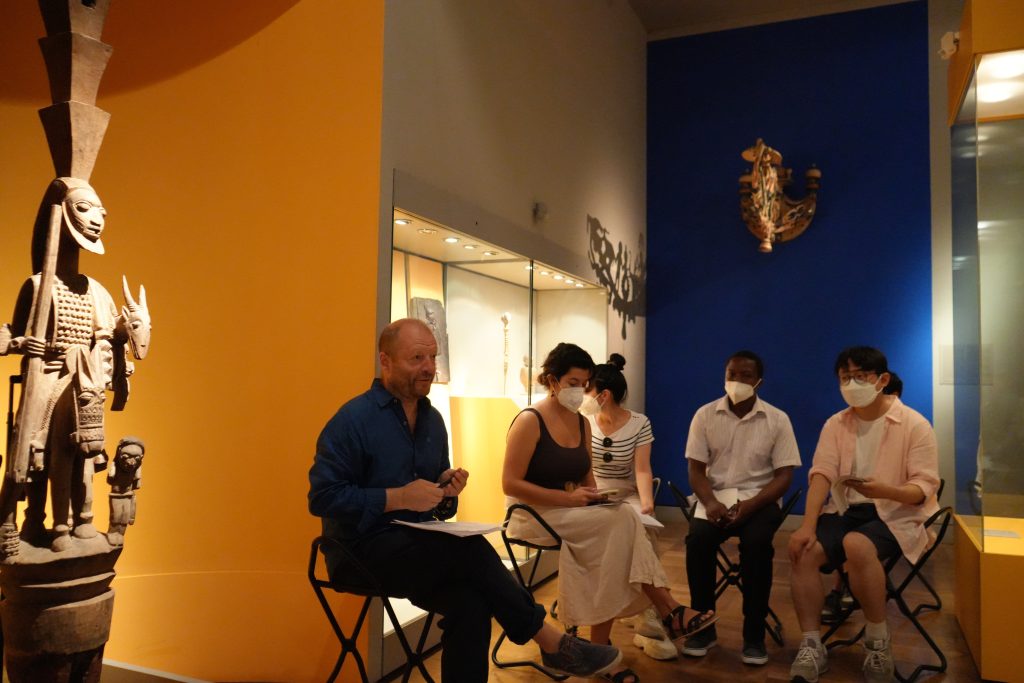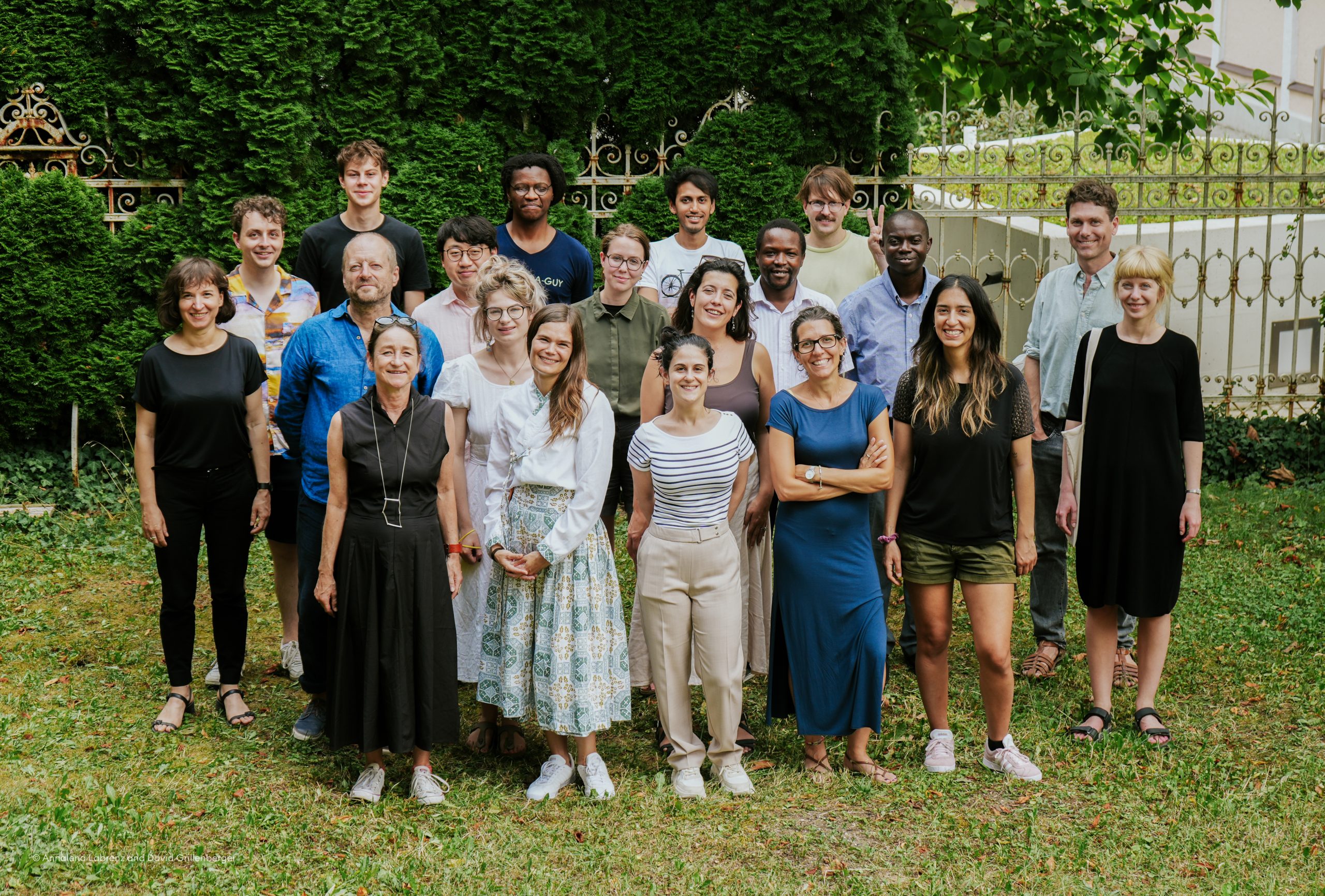In
Blog, Blog 2023
Continue Reading
covid and the theatre: a constant state of disruption?
christopher balme
Looking back upon the last couple of years, I am reminded of the famous advertisement for the film Jaws (1975): Just when you though it was safe to go back in the water… (For an impressionable teenager growing up in New Zealand next to a beach frequented by sharks, including Great Whites, this was not just rhetoric but calculated risk assessment). However, for the world of theatre, music and the live performing arts, this summer seemed to be safe to go back into the auditorium. Restrictions were loosened, masks discarded, and there was nothing preventing the theatres from a experiencing a boom: an explosion of pent-up energy which would send audiences streaming back into their subscription-season seats. Except – it didn’t happen or at least not in the expected numbers. Across the world theatres and opera houses have registered a certain reluctance on the part of audiences to get back in their seats. Britain’s leading theatre trade magazine The Stage headlined on 22 August 2022 during the Edinburgh Festival: ‘Covid is having “enormous but silent” impact on EdFringe’.[1] The final weeks of the theatre season in Germany were dominated by the term Publikumsschwund, i.e. dwindling audiences, and in far-off New Zealand theatres struggled with intermittent openings and closures, as Covid infections rose and fell. Each of these cases is slightly different but they all share a number of characteristics. The combination of cast and staff illness, spectatorial hesitancy and governmental restrictions creates suboptimal conditions for live theatre. Although discrete factors, they are often interrelated: for instance, recurrent infections in the cast lead to regular cancellations of performances, which in turn disillusion audiences, and even seasoned subscription-ticket veterans lose interest after the third cancellation. This article draws on a comparative study of theatre in the UK and Germany.[2] While still ongoing, we can provide some provisional insights and propose observations on the current iteration of theatre in crisis mode. Theatre under global pandemic conditions has proven to be a fruitful field to investigate dis:connectivity. The closure of theatres in March 2020 was a genuinely global measure and experience. Most theatres and indeed cultural venues of any kind shut down and remained that way well into 2021. Although the immediate impact is clearly economic, as the whole workforce employed in the performing arts sector was effectively laid off or placed on various furlough schemes, the long-term effects may be much wider. The closures produced absence in the form of a complete dearth of live performance. The flow of productions and personnel which is both local, national and international (especially opera) was interrupted for months, even years as carefully calibrated timetables evaporated; and hastily improvised workarounds (detours) in the form of streaming became all the rage. As the pandemic progressed, the topics changed from sheer economic survival to the pros and cons of digitalisation, to the mechanics of social distancing in a theatre auditorium. Currently, we are beginning to see the outlines of theatre under post-pandemic conditions: a loss of audience confidence, recurrent illness, and uncertainty in programming.Where have all the spectators gone?
In July 2022, the word of the month in the German theatre scene was Publikumsschwund. Numerous newspapers and magazines carried headlines featuring the term and all agreed that theatres had had a bad season even though there were few to no restrictions. The Süddeutsche Zeitung published a long article titled Der Einbruch: Dem Theater fehlen die Zuschauer (The collapse: The theatre lacks spectators),[3] in which the authors, theatre critics Peter Laudenbach (Berlin) and Egbert Tholl (Munich), presented results of a journalistic survey they had undertaken. Artistic directors (Intendanten) reported that theatres had lost half of their subscribers in the past two years — a brutal slump, also caused by the fact that many houses had to suspend their subscriptions in winter because of the pandemic restrictions. Prominent stages such as the Berlin Volksbühne were happy if they managed to sell 25% of seats. At Dortmund’s city theatre, artistic director Julia Wissert had an average of 44 paying spectators per performance over the past season — in a house with 500 seats. The harshest polemic is reserved for the Munich Kammerspiele:Fig.1 Berliner Ensemble. Seating according to the rules of social distancing. https://twitter.com/blnensemble/status/1278239898525466625/photo/1
The biggest failure of the Münchner Kammerspiele in the current season was a play about living and dying with Covid in intensive care. And apparently fewer and fewer audience members feel like being lectured from the stage with banalities critical of capitalism and the latest twists and turns of identity politics. Here the pandemic acts like an accelerant. It intensifies an audience crisis that badly managed theatres have brought on themselves. Their self-referentiality and arrogance are not likely to be a wise survival strategy in the face of failing audiences.[4]The polemic against certain forms of ‘progressive’ theatre is further sharpened by showing that theatres following mainstream programming, such as the Berlin Ensemble (84% capacity) or Munich’s own Volkstheater, could demonstrate robust attendance figures. The authors conclude that spectators are looking for either familiar titles, great acting or ‘genuine stories’. While the author-critics clearly have a critical axe to grind in respect to post-dramatic, experimental theatre (which programmatically eschews all three criteria), a recent empirical survey confirms the overall drop in attendance. In July 2022 the Deutsche Bühnenverein (the German-speaking theatre-managers association) presented the official theatre statistics for the previous season. Compared to 2018/2019, the last pre-Covid season, the 2020/21 season demonstrates a colossal 86% drop in attendance figures.[5] These figures represent the highpoint of the corona pandemic as well as periods of intermittent reopening and do not take account of the ‘recovery’ in spring and summer 2022. The figures are by any account dramatic and represent a major interruption of an established cultural practice: attending theatre.
Digital futures
During the deepest and darkest lockdowns in 2020, the brightest light shone digitally. Whether theatres streamed old recordings of past productions or began to produce bespoke productions for the internet (with various degrees of hybridity in between), digital theatre appeared to hold the key to new possibilities for theatre. Fans of German theatre based in New York suddenly gained gratis access to the digital vaults of the Schaubühne in Berlin going back to the 1970s, whereas disciples of Milo Rau’s NTGent, arguably the most talked-about theatre in Europe, could watch new productions online in high-quality, digital streams for a modest price (fig.2).The hype was, however, more discursive than actual. Characteristic for discursive hype is a collection of essays published quickly in autumn 2020: Lernen aus dem Lockdown? Nachdenken über Freies Theater (Learning from the lockdown? Reflections on independent theatre).[6] As the title indicates, the main focus is on the independent sector, which was especially hard hit by the total shutdown of all live performance. The embrace of digital technology, for example, is one of the more emphatic stances we find in the independent scene which implies a critique of entrenched positions. For example, in the article by Michael Annoff und Nuray Demir, Showcase im Splitscreen: Videobotschaften an die Dominanzkultur (Show case in a split screen: video messages to the dominant culture):Fig 2. Luc Perceval’s production of Yellow – The Sorrows of Belgium II: Rex at NTGent, an exploration of Belgian collaboration with the Nazis, was made available as a livestream in March 2021. New performances in November 2022 are no longer streamed. Image: https://www.ntgent.be/en/productions/yellow-ntgent
In the silence of the home office, old audience-development dreams are awakened, in which new groups of visitors are won over without having to change themselves…. But theatre will only emerge stronger from the crisis if it starts from scratch: with its programming and its dramaturgies. In 2018, The Carters shot their ‘APES**T’ video at the Louvre and quickly had more clicks than the museum had visitors all year.[7]To date 233 million views on YouTube suggest indeed that a rap video filmed in a high-culture temple finds more interest than a production from the independent performance scene.
Their point is that the video is a beautifully filmed and iconographically resonant work referencing numerous memes and tropes of Black culture, which demand exegesis using the tools of performance analysis. As the authors put it: ‘Mona Lisa had to settle for the role of an extra, like an aging silent film star’.[8] There is also a definite pessimistic undertone in their argument: ‘In the 2020 crisis, TikTok dances go through the roof. The audience figures for the lockdown programmes of German-language cultural institutions, however, are languishing in double digits’.[9] Can this discrepancy be bridged? The tension between the past and the future is framed in the Carters’ video as a form of Afrofuturism, and as a more universal digital future, a theme that runs through the collected essays like a red thread. It is a tension that remains unresolved, intentionally so, as the exponents of the metaphysics of presence defend positions against or in contrast to the advocates of the digital future. In the cold light of empirical research, the digital future appears less than incandescent. The survey cited above counted a total of 245 464 tickets sold for digital theatre, a small fraction of total sales (under pre-pandemic conditions the German-speaking theatres sell about 20 million tickets per annum). At least an increase in productions has been noted. In the last pre-Covid season of 2018/19, a total of zero digital productions was recorded versus 18% in the 2020/21 season, although the ticket sales suggest the attendance was quite modest.[10] Some theatres have introduced digital production units alongside the traditional divisions of drama, opera and dance. It remains to be seen whether they are here to stay. Theatre institutions around the world pin their claims for legitimacy and hence public funding on providing (performing) art as a ‘live’, not a digital experience.Fig.3 The Carters APES**T. YouTube screenshot.
Health and wellbeing
Liveness has proven to be the Achilles heel of theatre during the pandemic. While health concerns may keep some spectators away, they are potentially replaceable by other, less risk-averse, visitors. Infections among casts have been much more problematic. A single Covid case on the part of an important performer can lead to the performance being cancelled. Quarantine regulations in most countries generally enforce a period of isolation until a negative test can be produced (a minimum of five days). Theatre in New Zealand (and not just theatre) has been bedevilled by the household rule, which means all members of a household must quarantine when one member is infected. On the level of systemic comparison, we can observe the same problem leading to different but equally debilitating outcomes. In Germany, the repertoire and ensemble system – of which the country is so proud that it has applied to the UNESCO for ICH status (Intangible Cultural Heritage) – has proven to be particularly susceptible. Because a theatre keeps so many productions in repertoire, and many actors are often chronically overworked, parts are not understudied. When an actor playing Macbeth, or any other larger role, contracts Covid the performance is usually cancelled. Opera can handle the situation better on account of its classical repertoire. An ailing Madame Butterfly can be replaced at short notice by dozens of willing substitutes, who need only learn the moves of the mise en scène. The English theatre system, with its long runs and culture of understudies, has also fared better. Nevertheless, the independent theatre scene everywhere has suffered as the recent Edinburgh Fringe painfully demonstrated. The ‘enormous but silent impact’ quoted at the beginning of this essay refers to the absences and gaps created by cancelled performances caused in turn by sickness among cast members and venue staff. Linda Crooks, executive producer of the Traverse theatre in Edinburgh is cited as saying: ‘There’s several things we are trying to reconcile. We’re still managing what can be – on occasions – a highly debilitating virus that can knock out shows. We are trying to build back audience confidence and any mention of the first issue can impact on the second, which in turn hits the very fragile bottom line hard – against a backdrop of exorbitant costs.’[11] The Edfringe, as it is now known, is unique as a festival because it functions without curatorial control.[12] Groups and artists self-fund to attend and hope for the big break. While this state of precarity is not comparable to the long-term contracts enjoyed by German actors at publicly funded theatres, the dynamics are similar, except for the direct financial risk incurred.Outlook
Even in highly divergent theatre systems such as the German and the British, the effects of the pandemic have, and continue to be, highly isomorphic. Just as the pandemic generated remarkably similar responses around the globe, so too have theatres followed a roughly similar playbook. Consigned to lockdowns in the first phase, cautious openings and then renewed closures in the second and third phases, followed by more or less complete reopening since early 2022, theatres have done all in their power to return to the status quo ante. The utopian energy of the initial lockdowns, where dreams of a new theatre were articulated, has dissipated and been replaced by a high degree of uncertainty and pragmatic responses. The interruptions, gaps and workarounds created by the pandemic have, however, opened up new spaces that make a return to path-dependent patterns of production and reception ever more problematic. And the heating costs for the coming winter have not yet been factored in…. [1] Giverny Masso, ‘Covid Is Having “Enormous but Silent” Impact on EdFringe, Say Artists’, The Stage, 22 August 2022. [2] ‘Theatre After Covid’, Institute Website, The Royal Central School of Speech and Drama. University of London, 2022, https://www.cssd.ac.uk/Research/Research-Outputs-and-Projects/Current-Research-Projects/theatre-after-covid. [3] Egbert Tholl and Peter Laudenbach, ‘Der Einbruch. Dem Theater Fehlen Die Zuschauer.’, Süddeutsche Zeitung, 11 June 2022, https://www.sueddeutsche.de/kultur/theater-publikum-corona-krise-berliner-ensemble-1.5619166?reduced=true. [4] Tholl and Laudenbach (Author’s translation). [5] Detlev Baur, ‘Betriebsunfall Oder Zeitenwende?’, Die Deutsche Bühne, July 2022, 39. [6] Haiko Pfost, Falk Schreiber, and Wilma Renfordt, eds., Lernen Aus Dem Lockdown? Nachdenken Über Freies Theater (Berlin: Kindle Edition, 2020). [7] Michael Annoff and Demir Nuray, ‘Showcase Im Splitscreen: Videobotschaften an Die Dominanzkultur’, in Lernen Aus Dem Lockdown? Nachdenken Über Freies Theater, ed. Haiko Pfost (Berlin: Kindle Edition, 2020), 17 (Author’s translation). [8] Annoff and Nuray, 17 (Author’s translation). [9] Annoff and Nuray, 17 (Author’s translation). [10] Baur, ‘Betriebsunfall Oder Zeitenwende?’, 40. [11] Cited in: Masso, ‘Covid Is Having “Enormous but Silent” Impact on EdFringe, Say Artists’. [12] Audience attendance at the Fringe dropped by 25% compared to 2019. See: Giverny Masso, ‘Edinburgh Fringe Ticket Sales down 25% across Key Venues’, The Stage, 28 August 2022 This was attributed to a combination of high accommodation costs, disruption to public transport and high fuel costs.Bibliography
Annoff, Michael, and Demir Nuray. ‘Showcase Im Splitscreen: Videobotschaften an Die Dominanzkultur’. In Lernen Aus Dem Lockdown? Nachdenken Über Freies Theater, edited by Haiko Pfost, 16–22. Berlin: Kindle Edition, 2020. Baur, Detlev. ‘Betriebsunfall Oder Zeitenwende?’ Die Deutsche Bühne, July 2022, 38–40. Masso, Giverny. ‘Covid Is Having “Enormous but Silent” Impact on EdFringe, Say Artists’. The Stage, 22 August 2022. ———. ‘Edinburgh Fringe Ticket Sales down 25% across Key Venues’. The Stage, 28 August 2022. Pfost, Haiko, Falk Schreiber, and Wilma Renfordt, eds. Lernen Aus Dem Lockdown? Nachdenken Über Freies Theater. Berlin: Kindle Edition, 2020. The Royal Central School of Speech and Drama. University of London. ‘Theatre After Covid’. Institute Website, 2022. https://www.cssd.ac.uk/Research/Research-Outputs-and-Projects/Current-Research-Projects/theatre-after-covid. Tholl, Egbert, and Peter Laudenbach. ‘Der Einbruch. Dem Theater Fehlen Die Zuschauer.’ Süddeutsche Zeitung. 11 June 2022. https://www.sueddeutsche.de/kultur/theater-publikum-corona-krise-berliner-ensemble-1.5619166?reduced=true.citation information:
Balme, Christopher. ‘Covid and the Theatre: A Constant State of Disruption?’ Global Dis:Connect Blog (blog), 2 July 2023. https://www.globaldisconnect.org/02/07/covid-and-the-theatre-a-constant-state-of-disruption/.
7 February 2023






 Image: Martin Rempe
Image: Martin Rempe Ayala Levin's master class (Image: Annalena Labrenz & David Grillenberger)
Ayala Levin's master class (Image: Annalena Labrenz & David Grillenberger) The gd:c summer school takes a field trip to the Museum Fünf Kontinente. (Image: Annalena Labrenz & David Grillenberger)
The gd:c summer school takes a field trip to the Museum Fünf Kontinente. (Image: Annalena Labrenz & David Grillenberger) One, yet many (but not too many). (Image: Annalena Labrenz & David Grillenberger - the author in the back left with the snappy Hawaiian shirt)
One, yet many (but not too many). (Image: Annalena Labrenz & David Grillenberger - the author in the back left with the snappy Hawaiian shirt)